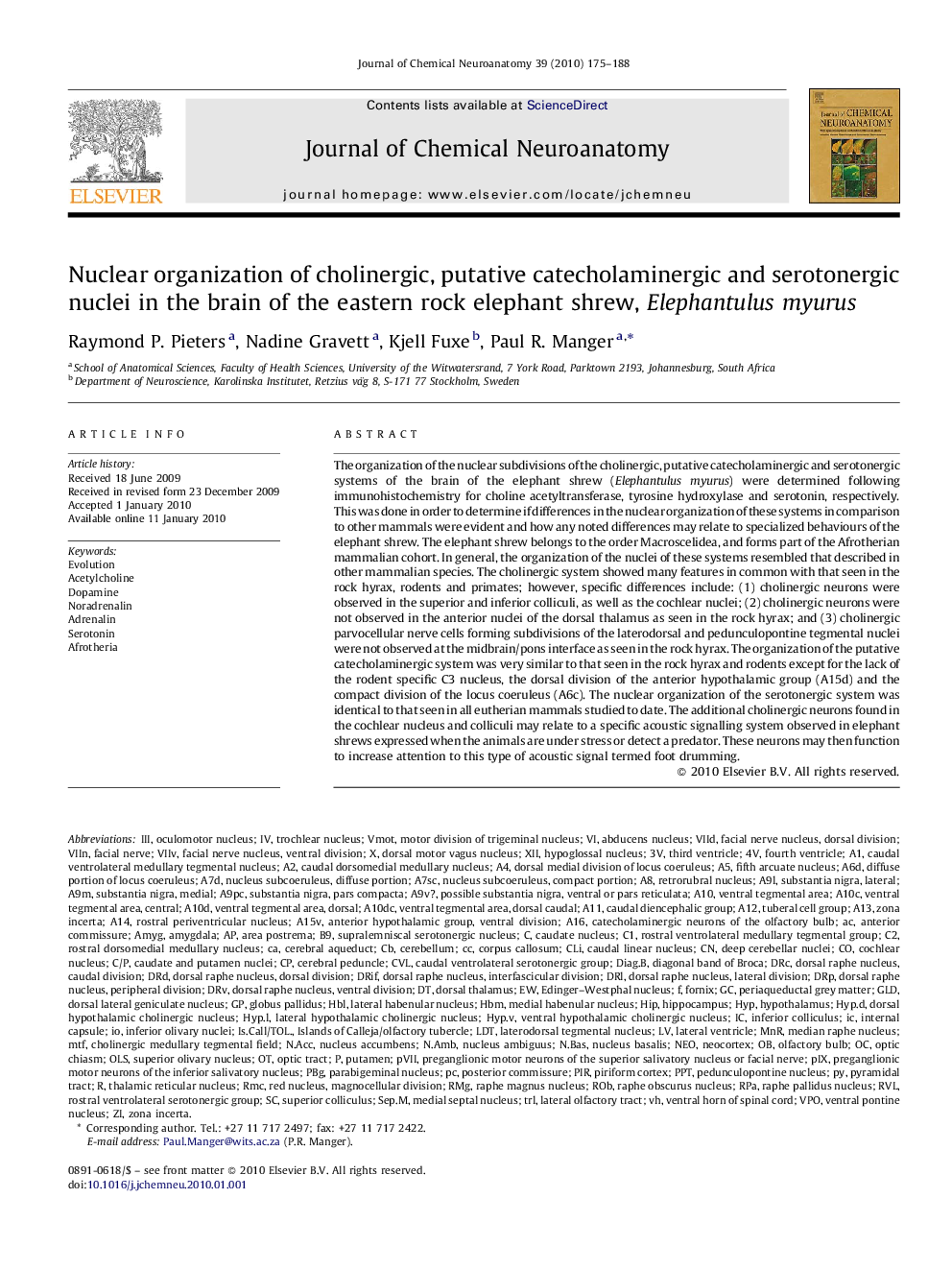| Article ID | Journal | Published Year | Pages | File Type |
|---|---|---|---|---|
| 1989111 | Journal of Chemical Neuroanatomy | 2010 | 14 Pages |
Abstract
The organization of the nuclear subdivisions of the cholinergic, putative catecholaminergic and serotonergic systems of the brain of the elephant shrew (Elephantulus myurus) were determined following immunohistochemistry for choline acetyltransferase, tyrosine hydroxylase and serotonin, respectively. This was done in order to determine if differences in the nuclear organization of these systems in comparison to other mammals were evident and how any noted differences may relate to specialized behaviours of the elephant shrew. The elephant shrew belongs to the order Macroscelidea, and forms part of the Afrotherian mammalian cohort. In general, the organization of the nuclei of these systems resembled that described in other mammalian species. The cholinergic system showed many features in common with that seen in the rock hyrax, rodents and primates; however, specific differences include: (1) cholinergic neurons were observed in the superior and inferior colliculi, as well as the cochlear nuclei; (2) cholinergic neurons were not observed in the anterior nuclei of the dorsal thalamus as seen in the rock hyrax; and (3) cholinergic parvocellular nerve cells forming subdivisions of the laterodorsal and pedunculopontine tegmental nuclei were not observed at the midbrain/pons interface as seen in the rock hyrax. The organization of the putative catecholaminergic system was very similar to that seen in the rock hyrax and rodents except for the lack of the rodent specific C3 nucleus, the dorsal division of the anterior hypothalamic group (A15d) and the compact division of the locus coeruleus (A6c). The nuclear organization of the serotonergic system was identical to that seen in all eutherian mammals studied to date. The additional cholinergic neurons found in the cochlear nucleus and colliculi may relate to a specific acoustic signalling system observed in elephant shrews expressed when the animals are under stress or detect a predator. These neurons may then function to increase attention to this type of acoustic signal termed foot drumming.
Keywords
Corpus callosumDRCA12HBMDRDLDTAMYGIIIDRPCVLGLDXIICLiHYPMtFDRVC/PA13A10A14DRLA11A16HBLA6dA7dA7scA9lA9mA9pcA10cA10dA10dcA15vVIIvsubstantia nigra, lateralsubstantia nigra, medialVmotVIIdcaudal dorsomedial medullary nucleusnucleus subcoeruleus, diffuse portionnucleus subcoeruleus, compact portioncatecholaminergic neurons of the olfactory bulbsupralemniscal serotonergic nucleusrostral dorsomedial medullary nucleuscaudal ventrolateral serotonergic groupDiag.BHyp.dHyp.lHyp.vdorsal motor vagus nucleusMnRAmygdalalateral ventriclethird ventriclefourth ventricledorsal thalamusabducens nucleussubstantia nigra, pars compactacerebral pedunclearea postremaDRifFacial nervefornixdiffuse portion of locus coeruleuscerebral aqueductPeriaqueductal grey matterCerebellumHIPventral tegmental area, centralventral tegmental area, dorsal caudalventral tegmental area, dorsalzona incertaventral tegmental areaEdinger–Westphal nucleushypoglossal nucleusoculomotor nucleusinferior olivary nucleiretrorubral nucleustrochlear nucleusLateral habenular nucleusCaudal linear nucleuscaudate nucleusmedian raphe nucleusmedial habenular nucleuscaudal ventrolateral medullary tegmental nucleusdeep cerebellar nucleidorsal lateral geniculate nucleusrostral periventricular nucleuslaterodorsal tegmental nucleuslateral hypothalamic cholinergic nucleusventral hypothalamic cholinergic nucleusdorsal hypothalamic cholinergic nucleusCochlear NucleusHypothalamusHippocampusfifth arcuate nucleusanterior commissureInferior colliculusinternal capsulecaudal diencephalic grouprostral ventrolateral medullary tegmental grouptuberal cell groupDiagonal band of Brocaanterior hypothalamic group, ventral divisionGlobus pallidus
Related Topics
Life Sciences
Biochemistry, Genetics and Molecular Biology
Biochemistry
Authors
Raymond P. Pieters, Nadine Gravett, Kjell Fuxe, Paul R. Manger,
